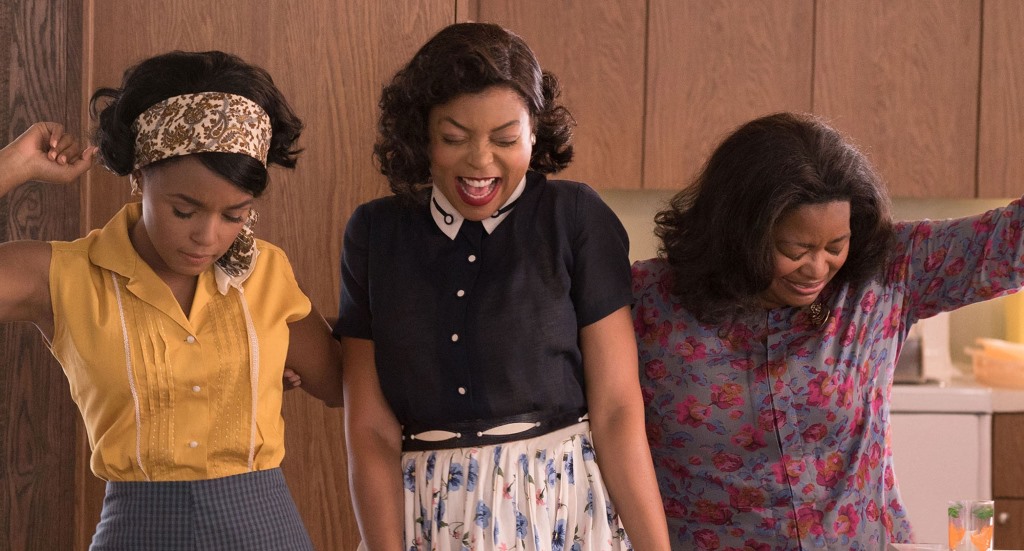‘Hidden Figures’ Simplifies Racial Realities
But the feel-good, smash hit about black women NASA specialists has strong moments.

Janelle Monae, Taraji P. Henson and Octavia Spencer in “Hidden Figures.” Photo from 20th Century Fox.
Unquestionably the surprise feel-good smash hit, congratulatory slap on the American back and elevation of black pride currently at the movie theaters is “Hidden Figures,” which has leapt to the forefront of national attention and even awards consideration. Sure, “La La Land” may win the Oscars and dominate the world box office, but not far behind and winning the comfort vote of American self-satisfaction is “Hidden Figures.”
It is a sign of how well the movie has absorbed the lessons of Hollywood’s narrative past and how desperate we are to believe in the fictional simplicities of re-shaping historical events into an acceptable formula of climax after climax.
In 1960s America it was unusual for a major daring initiative – launching man into space – to seek help even in the much maligned and neglected African American community for “human computers,” people so good with numbers and mathematical calculations that the skin color did not matter as much as their science.
There is actually a historical basis for “Hidden Figures” – black women whose talents fit into NASA’s needs to send Alan Shepard and John Glenn into space. Katherine Johnson was a whiz with numbers. Dorothy Vaughan had a knack with mathematical programming. Mary Jackson was determined to become NASA’s first black engineer. All have plaques and even buildings named after their work.
From such examples, “Hidden Figures” has built a powerful myth – three black women escorted into work at high speed by a white patrol office who momentarily out of patriotism sets aside his instinctive belligerence toward blacks. Setting aside belligerence in the face of ability is the fiction the movie rides to death.
There is some justification in elevating a forgotten chapter in history, but it is a fabrication to suggest it deeply changed society, unless you are living in a different society than I am.
Romance blossoms at a church picnic where a feisty black woman intellectually puts down a handsome officer to the amusement of her fellow workers. (At least this justifies the presence of another remarkable acting name to emerge this season, Mahershala Ali who is also in “Moonlight.”)
The movie is built of little set pieces like this that proclaim the characters’ worth, the indignities they suffer usually at white hands, how they persevere and on and on in clever but artificial elaborations of what was quiet pioneer heroism. It is how facts become legends, to paraphrase legendary director John Ford, whose movies preferred the legend but also showed the facts.
Taraji P. Henson plays Johnson in invented sequences of being forced to run to the colored woman’s restroom in a nearby building every time duty called, or confronting sympathetic but hard-nosed supervisor Kevin Costner about the demeaning treatment – which he rewards by offhand singular meetings and approval. Octavia Spencer plays Vaughan not just as the trainer of numbers teams but as the only person capable of figuring out the enormous IBM database of the time. Janelle Monae, who also has an impressive turn in “Moonlight,’ is the sassy Jackson (at least sassy in this version) determined to become a combination engineer, matchmaker and liberated woman.
All of this is enjoyable – in the sense of making the audience feel great about how openly and hard these women fight against prejudice and how the suspicious white world, mainly in the form of Costner and ever doubtful assistant Jim Parsons, eventually bends to the value of these black women. Of course, the hostility is exaggerated as is the acceptance.
If you trust the film, only because of these women’s involvement does Glenn make it around the world in space and return safely. Only because of their programming expertise does the IBM computer kick out reliable data. The film is smart enough not to say this directly but the images certainly imply that level of importance.
Director Theodore Melfi has absorbed well the lessons of movie construction of the past, how to build individual life lessons into an audience pleasing fairytale. In seeking to glorify these women by exaggerating their circumstances, the film may be doing a disservice to them and to history. That certainly is the reaction on reflection, though I think audiences will enjoy being led down the garden path of this vision of the 1960s era. Other movies set in the present are forcing reflection on a more genuine state of humanity.
Dominique Paul Noth served for decades as film and drama critic, later senior editor for features at the Milwaukee Journal. You’ll find his blog here and here.
Movies
-
Republican Legislators Push Tax Credits for Films Made in Wisconsin
 May 21st, 2025 by Baylor Spears
May 21st, 2025 by Baylor Spears
-
Mystery Movie Being Filmed in Milwaukee With Kevin Spacey
 Apr 24th, 2025 by Jeramey Jannene
Apr 24th, 2025 by Jeramey Jannene
-
Two Documentaries Offer Lessons in Fame
 Apr 24th, 2025 by Dominique Paul Noth
Apr 24th, 2025 by Dominique Paul Noth
Review
-
Eating Burmese in Bay View
 Dec 13th, 2025 by Cari Taylor-Carlson
Dec 13th, 2025 by Cari Taylor-Carlson
-
Casablanca Is a Milwaukee Success
 Nov 30th, 2025 by Cari Taylor-Carlson
Nov 30th, 2025 by Cari Taylor-Carlson
-
Oh, Those Witty 18th Century Brits
 Nov 24th, 2025 by Dominique Paul Noth
Nov 24th, 2025 by Dominique Paul Noth















The Civil Rights movement is way before my time. I’m also white. I loved the movie for the amazing message to young girls. That math isn’t “hard” as so many are brainwashed to believe. And that careers in the STEM fields (science, technology, engineering,and math) can be filled with exciting projects – like sending someone into space – and amazing successes. That these fields do, indeed, need women.
And that it’s because of women like Vaughan, Johnson, and Jackson that such careers are possible for women today.
It was, indeed, a Hollywood-ed up version of history, yes. But it was also quite motivational for young girls.
I do agree that it was motivation, but I also point out how it was souped up and even the director admits:
http://atlantablackstar.com/2017/02/01/hidden-figures-director-defends-decision-add-fictitious-white-savior-scenes-movie/